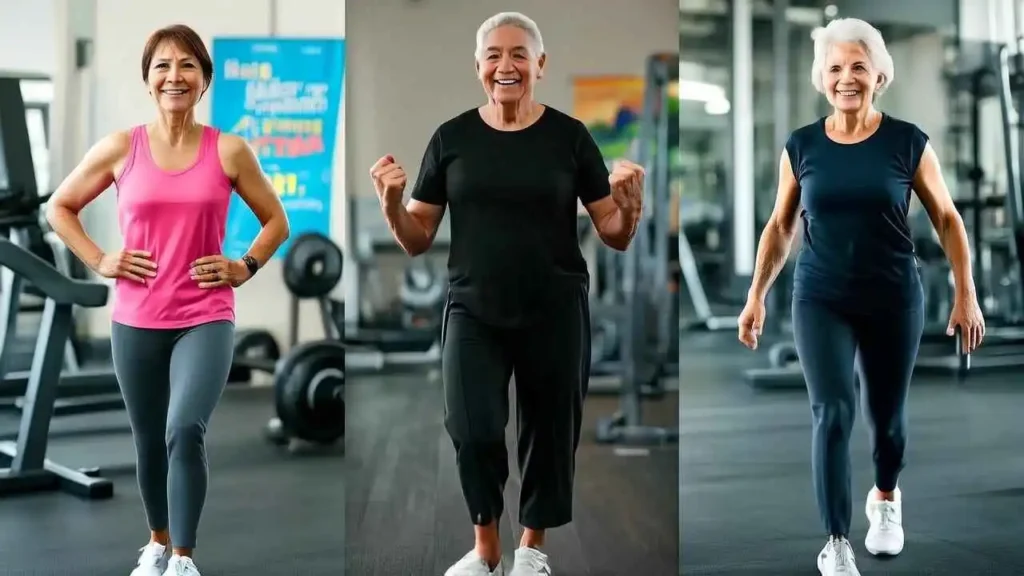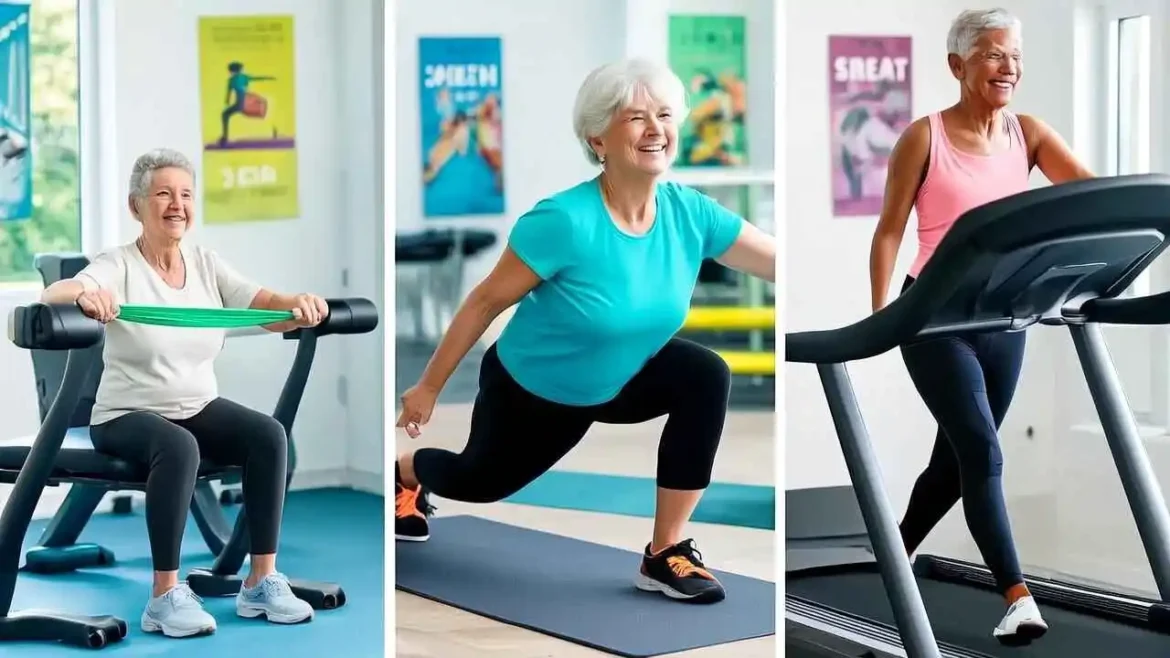
Unlocking the Code: The Secrets Behind Jacqueline Hooton’s Strength at 62
In an era dominated by fleeting digital trends and quick-fix promises, certain figures emerge who command our attention not through elaborate stunts, but through sheer, undeniable authenticity. Jacqueline Hooton is one such figure. When we scroll through our feeds and land on her profile, we see more than just a fitness enthusiast; we see a 62-year-old grandmother, former model, and art director who is redefining what it means to age with power, grace, and unapologetic strength.
The immediate question that springs to our minds is, “What is her secret?” How does she maintain such vitality, muscle definition, and energy in her sixties, a decade society has long—and wrongly—associated with decline? The truth, as we’ve discovered, isn’t a single, mystical secret. Instead, it’s a meticulously built lifestyle founded on evidence-based principles, unwavering consistency, and a profound mindset shift. Let’s break down the core pillars of her philosophy to understand the “secret” behind her enduring strength.
Pillar 1: Challenging the Narrative with Strength Training – Redefining Age and Capability
For far too long, the prevailing advice for older women has been a cautious, even limiting, refrain: “take it easy.” This outdated narrative often perpetuated the idea that declining physical prowess was an inevitable consequence of aging. Gentle walks, sporadic water aerobics, or a few light stretches were frequently presented as the absolute ceiling of physical capability, subtly discouraging any pursuit of true strength or significant physical challenge. Jacqueline Hooton, through her remarkable personal journey and powerful advocacy, fundamentally shatters this restrictive, ageist paradigm. The indisputable cornerstone of her astonishing physical prowess, vitality, and enduring independence is a commitment to progressive strength training.
This isn’t about aimlessly lifting weights or chasing fleeting trends; it’s a deeply strategic, scientifically grounded approach centered on continuously challenging the muscles to adapt, grow stronger, and become more resilient. This deliberate and systematic overload is not merely beneficial, but absolutely crucial for women, particularly in the post-menopause years. During this significant life stage, the natural decline in estrogen levels can dramatically accelerate the loss of precious muscle mass – a debilitating condition known as sarcopenia – and significantly diminish bone density, leading to the increased fragility associated with osteoporosis. Strength training acts as a powerful counter-measure, not just slowing, but often reversing these age-related declines.
Here’s an in-depth look at why progressive strength training forms the unwavering bedrock of Jacqueline’s routine and why it should be a priority for every woman:
- Increased Metabolism & Body Composition: Muscle is a metabolically active tissue, far more so than fat. By increasing and maintaining muscle mass, you effectively stoke your body’s internal furnace, significantly boosting your resting metabolic rate. This means your body burns more calories even when you’re at rest, making it dramatically easier to manage weight, maintain a healthy body composition, and reduce the risk of metabolic disorders like type 2 diabetes. It transforms your body into a more efficient, calorie-burning machine.
- Enhanced Bone Density & Fracture Prevention: The stress that weight-bearing and resistance exercises place on our bones is a vital signal to the body to actively build them up stronger. This mechanical stimulation encourages the deposition of new bone tissue, directly combating the insidious progression of osteoporosis and dramatically reducing the risk of debilitating fractures. Stronger bones mean greater resilience against falls, preserving independence and mobility long into later life. It’s a proactive investment in your skeletal health.
- Unrivaled Functional Strength & Independence: This benefit transcends the gym; it’s about real-world capability that profoundly transforms everyday life. Functional strength translates directly into being able to carry heavy groceries with ease, lift and play with grandchildren without strain, confidently move furniture, garden without discomfort, or simply get up from a low chair independently. It’s the cornerstone of maintaining autonomy, preserving personal dignity, and ensuring a vibrant, high quality of life for decades to come, enabling you to live life on your own terms, rather than being limited by physical constraints.
- Profound Mental Health & Cognitive Benefits: The physical act of training triggers the release of potent endorphins – your body’s natural mood elevators and pain reducers – which provide a powerful antidote to stress and anxiety. Beyond the biochemical response, the consistent sense of accomplishment, mastery, and empowerment that comes from progressively getting stronger is deeply satisfying. This journey of self-improvement fosters resilience, boosts self-esteem, combats feelings of isolation or depression, and can even enhance cognitive functions such as focus and discipline. Strength training becomes a powerful tool for holistic well-being.
As Jacqueline herself passionately articulates, her philosophy extends beyond the physical: “You don’t have to ‘look’ a certain age, whatever that even means. You certainly don’t have to ‘act’ it. I firmly believe in being age-proud, in owning every single year, and in showing up for yourself with the respect your body deserves.” Her journey is a living testament that embracing strength training is not just about extending life, but enriching it – building a more capable, resilient, and joyously independent future at any age.
Pillar 2: Nutrition as Fuel, Not Punishment
You simply cannot build a strong physique without the right building blocks. Hooton’s nutritional approach is as pragmatic and sustainable as her fitness regimen. It’s not about extreme restriction, fad diets, or demonizing entire food groups. Instead, it’s about viewing food as essential fuel for performance, recovery, and overall health.
We can distill her philosophy into a few key principles, which offer a refreshing alternative to the confusing diet culture we are often exposed to.
Jacqueline Hooton’s Nutritional Philosophy
| Principle | Explanation | Practical Application |
| Prioritize Protein | Protein is the essential macronutrient for muscle protein synthesis—the process of repairing and building muscle tissue after a workout. Adequate protein intake is non-negotiable for anyone serious about strength. | Aiming for a protein source with every meal, such as lean meats, fish, eggs, Greek yogurt, tofu, or high-quality protein powder. |
| Embrace Whole Foods | The bulk of her diet comes from nutrient-dense, unprocessed foods. These provide the vitamins, minerals, and fiber necessary for optimal bodily function, energy levels, and gut health. | Building meals around vegetables, fruits, lean proteins, and healthy fats like avocado, nuts, and olive oil. |
| Strategic Carbohydrates | Carbohydrates are not the enemy; they are the body’s primary energy source. She consumes them strategically to fuel her demanding workouts and replenish glycogen stores afterward. | Focusing on complex carbohydrates like oats, quinoa, sweet potatoes, and brown rice, especially around workout times. |
| No “Bad” Foods | A sustainable approach allows for flexibility and enjoyment. Labeling foods as “good” or “bad” leads to a cycle of guilt and restriction. Hooton’s method is about balance and moderation. | Enjoying a piece of chocolate or a favorite meal without guilt, understanding that consistency over time is what truly matters. |
This balanced, protein-forward approach ensures her body has everything it needs to recover from tough workouts and build lean muscle, all while supporting her overall well-being.
Pillar 3: The Unshakeable Power of Consistency and Mindset
While targeted training and intelligent nutrition are the “what” of transformation, this third pillar is the profound “how.” It is the bedrock upon which all physical progress is built, and it may be the most crucial—and often overlooked—component of Jacqueline Hooton’s remarkable success. Think of it this way: the most effective workout plan and the most perfect diet are merely blueprints. They are useless without the discipline, grit, and mindset to show up and build, day after day. Jacqueline’s “secret,” if there is one, is not found in a specific exercise or magical supplement; it is found in the quiet, unglamorous commitment to showing up. Day after day, week after week.
This isn’t about chasing perfection or expecting every session to be a personal best. Life is messy, and energy levels fluctuate. True success lies in honoring the commitment she has made to herself, even on the days she doesn’t “feel like it.” This psychological fortitude is not an accident; it is a skill, cultivated through a powerful and intentional mindset built on these key ideas:
1. Discipline Over Motivation: The Engine vs. The Spark Motivation is a wonderful but fleeting emotion. It’s the spark that gets you started, the wave of enthusiasm that follows a new goal or an inspiring post. But like any emotion, it ebbs and flows, completely unreliable as a long-term strategy. Discipline, on the other hand, is the engine. It’s a cultivated habit, a system you build. Jacqueline doesn’t wait for the feeling of motivation to strike before she trains. She has made fitness a non-negotiable part of her identity and her schedule, just like brushing her teeth or sleeping. By treating her workouts as appointments with herself, she removes the daily internal debate. The decision has already been made. This is how you build the “muscle of discipline,” which grows stronger with every repetition, ensuring you stay the course long after the initial spark of motivation has faded.
2. Rejecting Ageism: Rewriting the Narrative Society often hands us a script about aging—one filled with decline, limitations, and cautionary tales of what we “shouldn’t” do past a certain age. Jacqueline Hooton actively refuses to read from this script. She understands that age is a chronological fact, but it does not have to be a cage. Her approach is a conscious act of rebellion against self-imposed and societal limitations. By ignoring the narrative that strength training is for the young, she has opened up a world of potential that many people prematurely close off to themselves. This isn’t just about physical strength; it’s a profound mental shift. It fosters a mindset of lifelong learning and growth, proving that vitality, power, and progress have no expiration date.
3. Focus on Performance, Not Perfection: The Power of “Can Do” In a world saturated with aesthetic ideals, it’s easy to fall into the trap of working out to “fix” perceived flaws. This approach is often rooted in negativity and can lead to a fraught relationship with one’s body. Jacqueline’s focus is radically different and far more empowering. Her primary goal in the gym is to perform well and get measurably stronger. The questions she asks are not, “How do I look?” but “Can I lift 5 more pounds? Can I hold this for 10 more seconds? Is my form more stable than last week?” This performance-based focus shifts the goal from an external, often unattainable ideal of perfection to an internal, tangible sense of capability. This creates powerful intrinsic motivation that comes from within, building self-efficacy and a deep, appreciative connection with what her body can do. The positive physical changes become a welcome byproduct of this process, not the sole, frustrating focus.
4. The Importance of Rest: The Architecture of Strength The modern hustle culture often glorifies relentless work, but the wisest athletes know a powerful truth: strength isn’t built in the gym; it’s built during recovery. The act of lifting weights creates microscopic tears in the muscle fibers. It is during periods of rest—particularly quality sleep—that the body repairs these fibers, building them back stronger than before. Hooton understands that rest days, adequate sleep, and stress management are not signs of weakness or laziness; they are a strategic and non-negotiable part of her training protocol. Pushing endlessly without adequate recovery is a direct path to burnout, injury, and stagnation. By prioritizing rest, she ensures her body has the resources it needs to adapt, grow stronger, and maintain the consistency that is the very heart of her success. Discipline gets her to the gym, but intelligent recovery allows her to keep coming back.
Putting It All Together: A Blueprint for Strength
To transform the principles of effective training into practical application, we’ve developed a sample weekly fitness schedule inspired by her methodology. This proposed routine is not an exact replication of her training plan, but rather a thoughtful representation of the essential balance between rigorous workouts and sufficient recovery time to ensure optimal performance and sustained progress.
Sample Weekly Fitness Schedule
| Day | Focus | Notes |
| Monday | Upper Body Strength | Engage in compound movements such as the bench press, overhead press, various rowing exercises, and pull-ups. For those who may find pull-ups challenging, assisted variations can be utilized to build strength progressively. Aim for 3-4 sets of 8-12 reps to effectively target the major muscle groups in the upper body. |
| Tuesday | Active Recovery | Incorporate Low-Intensity Steady-State (LISS) cardio into your routine. Activities like a brisk 30-60 minute walk or light cycling can enhance blood circulation and promote recovery. Additionally, dedicate time to mobility work—including stretches and foam rolling—to improve range of motion and alleviate tightness. |
| Wednesday | Lower Body Strength | Focus on key compound lifts such as squats, deadlifts, and lunges to build foundational strength in the lower body. Supplement these core lifts with accessory exercises, including leg presses and calf raises, to target the smaller muscle groups. Aim for 3-4 sets of 8-12 reps to ensure a balanced strength-building process. |
| Thursday | Rest or Active Recovery | Designate this day for complete rest or engage in very light activities, such as gentle stretching or a leisurely stroll. It’s essential to listen to your body, recognizing when it needs a break to recover fully, ultimately enhancing performance for future workouts. Make this a day of self-care to benefit your overall well-being. |
| Friday | Full Body Strength | Incorporate a comprehensive workout that includes exercises targeting all major muscle groups. This session should primarily focus on higher rep ranges, typically 10-15 reps, to promote endurance and muscular adaptation. Effective options could include circuit-style training to keep the heart rate elevated while building strength. |
| Saturday | LISS Cardio & Core | Dedicate 30-45 minutes to a session involving steady-state cardio on machines such as the treadmill, elliptical, or rowing machine. Afterward, shift focus to core strengthening exercises. Consider including planks, Russian twists, and hanging leg raises to enhance core stability and overall training effectiveness. |
| Sunday | Rest & Preparation | Allow yourself a full rest day devoted to recovery and relaxation. Focus on hydration, consuming nutritious meals, and preparing meal preps for the upcoming week. This practice not only supports physical recovery but also sets a positive tone for the coming week, ensuring you are well-prepared mentally and physically for new challenges. |
By following this structured weekly fitness schedule, individuals can effectively balance their training and recovery, leading to improved strength, enhanced performance, and overall well-being. The key is to maintain consistency while remaining flexible, adjusting based on personal needs, workout intensity, and the body’s signals. As you grow stronger, feel free to modify the plan to suit your evolving fitness journey.



